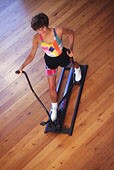
TUESDAY, Feb. 19 (HealthDay News) — Although physical activity can help boost your immune system, people who are sick should tone down their workout or skip it altogether, experts advise.
“Regular exercise is a great way to reduce stress and sleep better at night. This helps boost your immune system. However, vigorous exercise and extreme conditioning can have a negative impact on your health if you’re sick,” Joe Berg, a personal trainer and fitness specialist at Loyola Center for Health, said in a Loyola University news release.
“When fighting a viral illness, it’s best to keep your exercise session short and not as intense. If you have a fever or stomach bug it might be best to hold off,” Berg added.
For those recovering from an illness, it’s best to ease back into a workout routine slowly. Berg recommends starting small with some light aerobics, such as walking and cycling at an easy pace as well as body weight squats, push-ups and planks. In the plank exercise, you rest your weight on your forearms with your elbows directly beneath your shoulders, keeping your body in a straight line from your head to your feet.
“These exercises cover the major muscles of the body and when performed in moderation, can help boost your immune system,” explained Berg.
For people worried about being exposed to germs at the gym, Valerie Walkowiak, medical integration coordinator at the Loyola Center for Fitness, pointed out that heading outside or working out at home may be a good way to stay healthy and fit during the cold and flu season.
“Weather permitting, it’s always great to just get out of the house and walk or run to get in some cardio exercise. Just make sure you wear the proper clothes to keep warm. This includes layers of clothing, a hat, scarf, gloves and appropriate shoes,” said Walkowiak.
When the weather makes exercising outdoors impossible, there are ways people can work out at home — even if they don’t have special equipment. Walkowiak said you can get your heart rate up without leaving the house by climbing the stairs, jogging in place or doing jumping jacks. She added that a home-based circuit training routine can be created by alternating two to three minutes of these cardio exercises with 30 to 60 seconds of strength-training moves, such as push-ups, squats, seated rows or heel raises.
“You don’t have to have dumbbells, bands or tubing to get in some strength training at home. Try using household items to add resistance such as soup cans, gallon jugs of water or your own body weight,” Walkowiak noted.
In order to target all the muscle groups, Walkowiak recommended doing the following exercises:
- Chest, shoulder and triceps: do push-ups on the floor or against a wall
- Back, rear shoulders and biceps: try seated or standing row exercises using soup cans
- Legs, glutes and core: perform squats, sit-to-chair stands or lunges
- Calfs: do heel raises on the edge of a step
- Core: do planks, abdominal crunches, abdominal twists and leg raises
- Biceps: do bicep curls using soup cans
- Triceps: using a soup can or weighted object do kickbacks or over presses
Anyone who does go to the gym should remember to wipe down machines and wash their hands often, the experts advised.
More information
The U.S. Centers for Disease Control and Prevention has more about how to stop the spread of germs.

